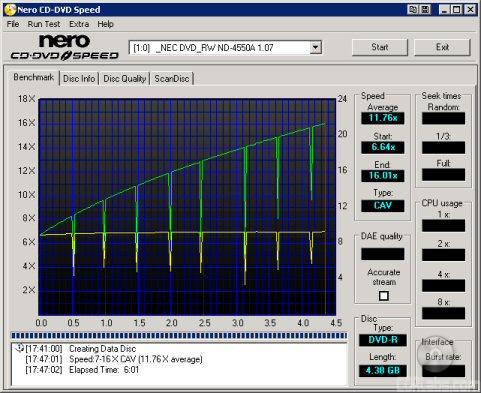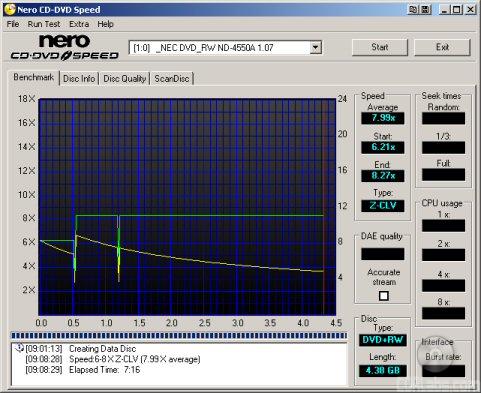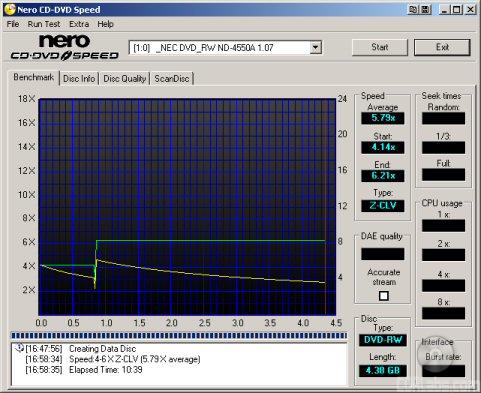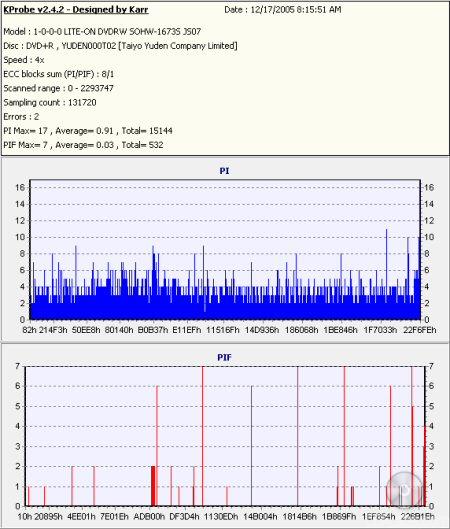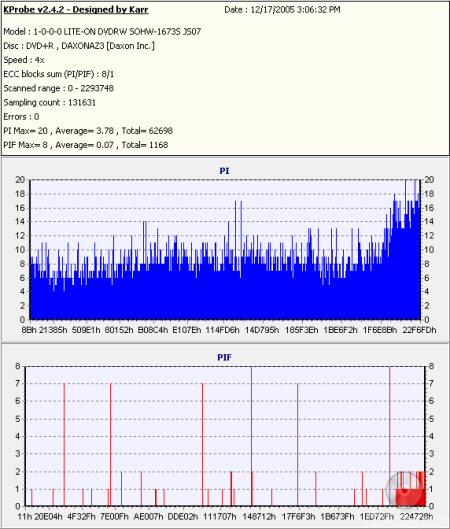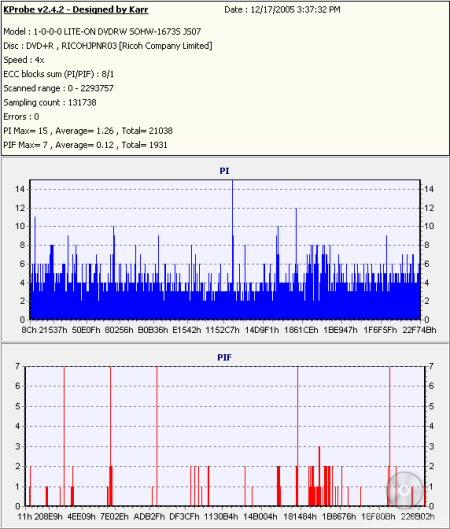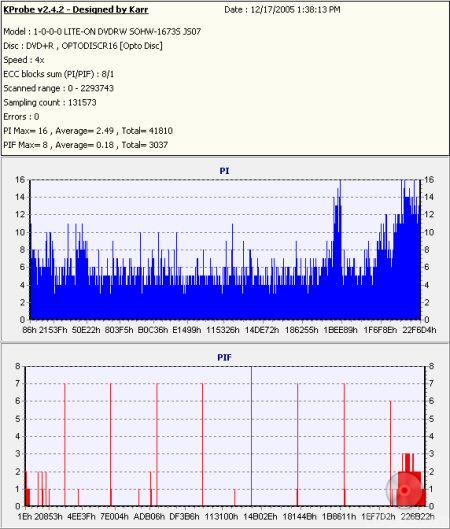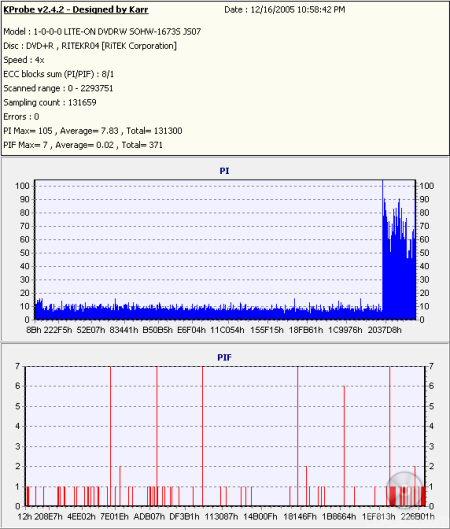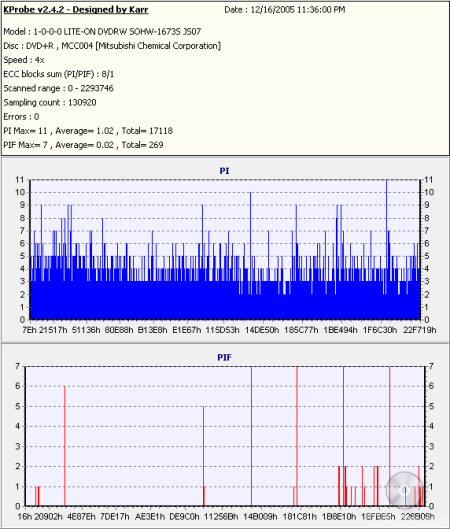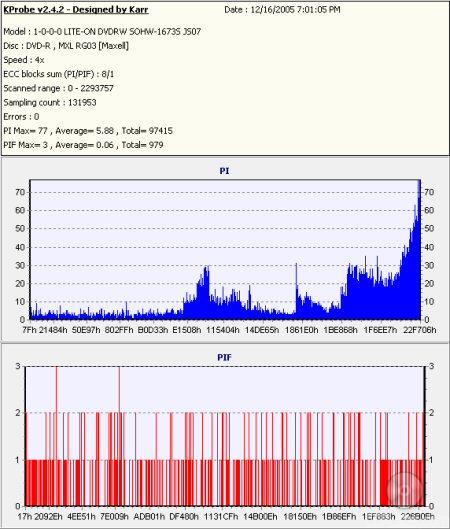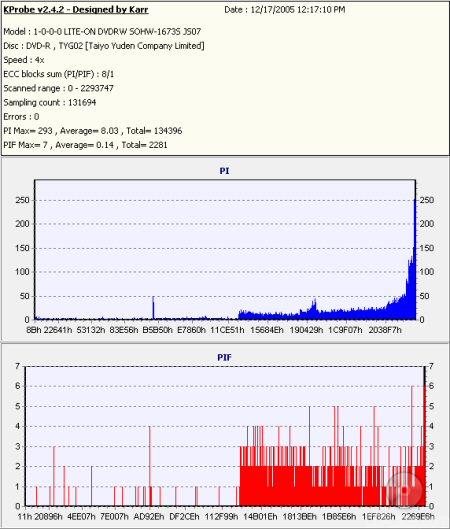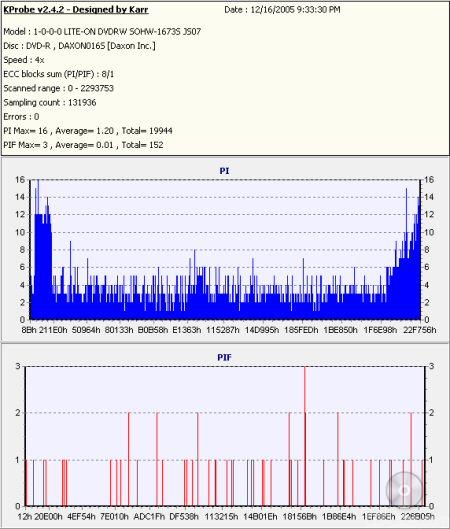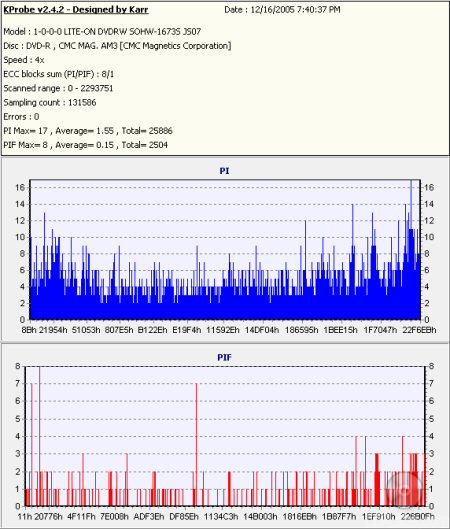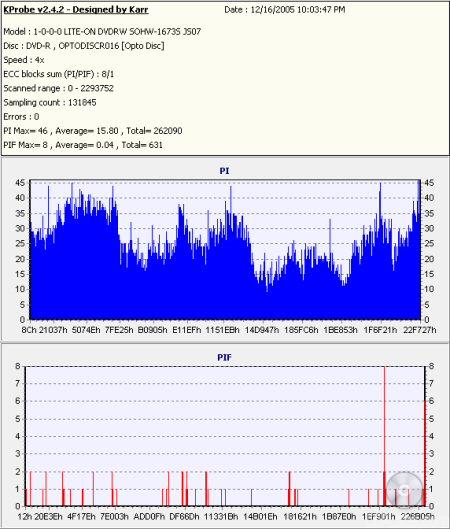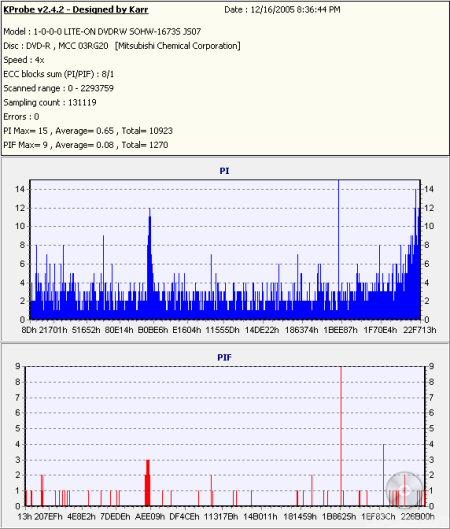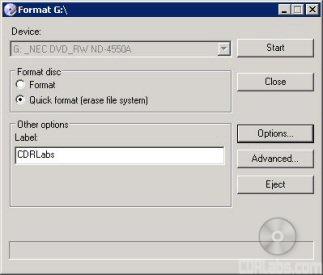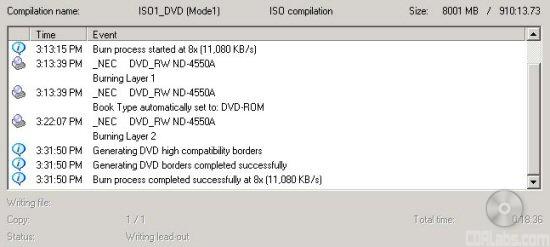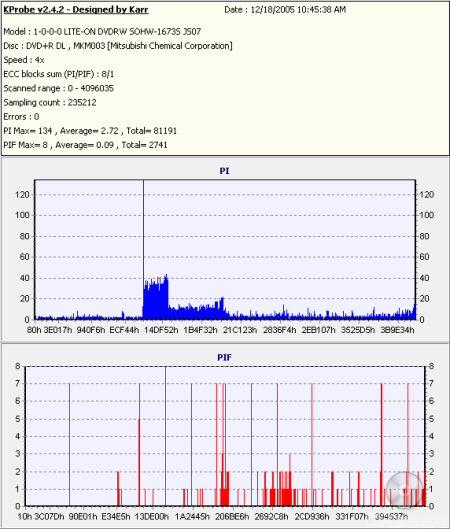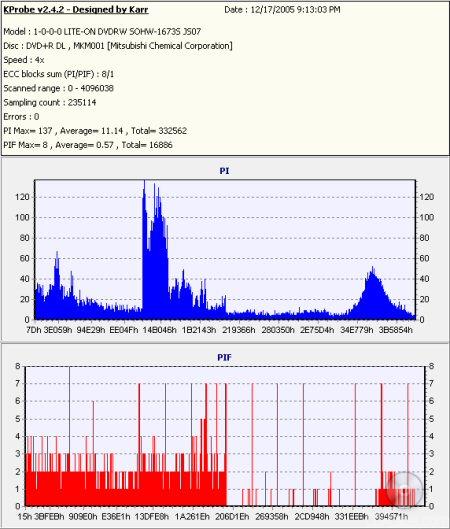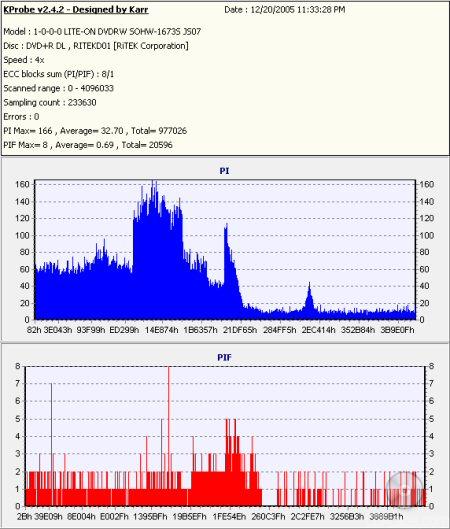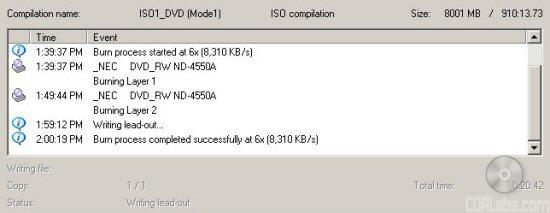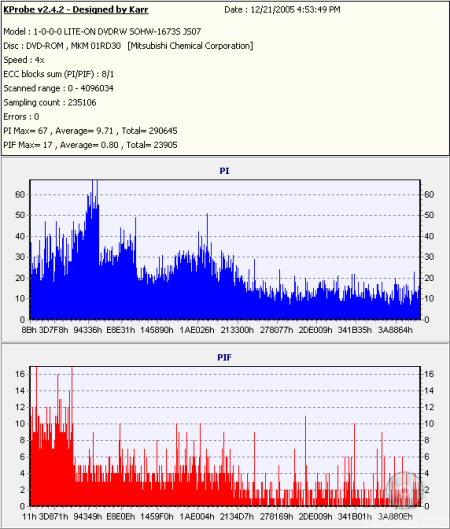DVD Write and ReWrite Tests - Nero Burning Rom 6.6.0.16 and DLA 4.95:
To test the DVD writing performance of NEC's new drive I used Verbatim 16x DVD+R, 16x DVD-R, 8x DVD+RW and 6x DVD-RW media. To get the writing times, a 4.38GB image was burned to our test discs using Nero.
When writing to DVD+R and DVD-R media at 16x, the ND-4550A uses CAV. By looking at the screenshots above, you can see that NEC's new drive starts writing at about 6.64x and accelerates, reaching its maximum speed as it reaches the end of the disc.
As I've mentioned in the past, the dips in the graphs are not an indication of poor performance and/or writing quality. They're due to the ND-4550A's Active Optimized Power Control (Active OPC) technology. According to NEC, this system actively monitors writing power and reflection of the media in use. By doing so, the drive can calculate the optimum laser power and adjust it in real-time.
The ND-4550A also features 8x DVD+RW and 6x DVD-RW writing speeds. In both cases the drive uses Z-CLV to reach its maximum DVD+RW writing speed.
| NEC ND-4550A |
LG GSA-4167B |
Sony DRU-810A |
Plextor PX-716A |
|
| DVD+R | 6:10 | 5:31 | 5:52 | 5:59 |
| DVD-R | 6:06 | 5:33 | 6:31 | 6:01 |
| DVD+RW | 7:16 | 7:20 | 7:42 | 7:35 |
| DVD-RW | 10:34 | 9:59 | 10:24 | 14:46 |
NEC's new drive performed relatively well in our DVD writing tests. While its Z-CLV writing method put it at a slight disadvantage when writing to DVD-RW discs, the ND-4550A turned in some pretty good times with DVD+R, DVD-R and DVD+RW media.
To check the media compatibility of the ND-4550A, I ran a few tests using some of the media available in my area. The media types, along with the average time it took the drive to write our 4.38GB image, are listed below.
| Manufacturer ID | Max Write Speed |
Average Write Time |
|
| Taiyo Yuden 8x DVD+R | YUDEN000T02 | 16x | 6:08 |
| Daxon 16x DVD+R | DAXONAZ3 | 16x | 6:08 |
| Memorex 16x DVD+R | RICOHJPN R03 | 16x | 6:10 |
| Optodisc 16x DVD+R | OPTODISCR16 | 16x | 6:12 |
| RiDATA 16x DVD+R | RITEKR04 | 16x | 6:10 |
| Verbatim 16x DVD+R | MCC-004 | 16x | 6:10 |
| Maxell 8x DVD-R | MXL RG03 | 16x | 5:38 |
| Taiyo Yuden 8x DVD-R | TYG02 | 12x | 7:55 |
| Daxon 16x DVD-R | DAXON016S | 16x | 5:38 |
| Memorex 16x DVD-R | CMC MAG.AM3 | 16x | 5:22 |
| Optodisc 16x DVD-R | OPTODISCR016 | 16x | 5:40 |
| Verbatim 16x DVD-R | MCC 03RG20 | 16x | 5:33 |
So what about writing quality? Testing a drive's DVD writing quality isn't easy. Until now, there were very few options, unless you wanted to shell out thousands of dollars for a certified test machine. Thanks to KProbe, we can test a disc's PI (Parity Inner) and PIF (Parity Inner Fail) rates.For these tests I used a Lite-On SOHW-1673S (firmware JS07) and read the discs at 4x with the PI and PIF ECC sums set to 8 and 1 respectively. For comparison, I also tested the discs on a BenQ DW1640. When combined with Nero CD Speed, the DW1640 is able to report PI Errors, PI Failures, Parity Outer Failures and even jitter levels. For this test, the discs are read at 8x with both the PI and PIF ECC sums set to 8.
So what are "good" results supposed to look like? With KProbe, the PI errors should not exceed 280 and the number of PIF errors should stay below 4. When testing with CD Speed, the number of PI errors should stay below 280 as well. However, because it scans with an ECC sum of 8, a higher number of PIF errors is acceptable, as long as they do not exceed 32. Since POF errors are uncorrectable, we really don't want to see any of them at all.
I also put these discs through a "stress test" by reading them back at 16x with the DW1640. By reading these discs back at this speed, we can see if there are any readability issues caused by the number of errors or high levels of jitter.
|
|
|
||||||||||||||||||||||||||||||||||||||||||||||||||||||||||||||||||||||||
|
|
|
||||||||||||||||||||||||||||||||||||||||||||||||||||||||||||||||||||||||
Looking at the graphs above, you can see that the results were fairly good with KProbe. Aside from a few isolated PIF spikes, the error rates remained relatively low. For whatever reason though, we saw a large PI/PIF/POF spike at the 2.25GB mark when testing with the DW1640. This happened with most of the DVD+R media we tried and the only way we found to eliminate it was to write at 8x or slower.
I'd be lying if I said I wasn't a little concerned with this spike, especially considering we didn't see anything like this with NEC's previous DVD writers. Nevertheless, it only showed up when testing with BenQ drives and it didn't seem to have any effect on the ND-4550A's ability to read the discs back.
|
|
|
||||||||||||||||||||||||||||||||||||||||||||||||||||||||||||||||||||||||
|
|
|
||||||||||||||||||||||||||||||||||||||||||||||||||||||||||||||||||||||||
Lastly, here are some results from our DVD-R test media. Aside from the PI/PIF spike, the results were pretty good for the most part. The only exception was TY's 8x media. While there weren't any PO Failures, the discs failed to complete our stress test, returning an error part way through.
| NEC ND-4550A |
LG GSA-4167B |
Sony DRU-810A |
Plextor PX-716A |
|
| DVD+RW Quick | 10 seconds | 9 seconds | 13 seconds | 32 seconds |
| DVD+RW Full | 7:19 | 7:23 | 7:43 | 7:46 |
| DVD-RW Quick | 36 seconds | 34 seconds | 34 seconds | 1:03 |
| DVD-RW Full | 14:20 | 10:05 | 10:23 | 15:09 |
Something to point out is that while the ND-4550A had no problems erasing DVD+RW discs at 8x, it erasedDVD-RW media at only 4x.
To test the ND-4550A's packet writing performance I used DLA 4.95. Verbatim 8x DVD+RW and 6x DVD-RW media were used once again.
| NEC ND-4550A |
LG GSA-4167B |
Sony DRU-810A |
Plextor PX-716A |
|
| DVD+RW Write | 6:29 | 6:31 | 6:48 | 6:33 |
| DVD+RW Read | 14:39 | 9:05 | 6:07 | 5:47 |
| DVD-RW Write | 12:13 | 8:26 | 8:46 | 12:44 |
| DVD-RW Read | 6:10 | 8:40 | 6:11 | 6:05 |
The ND-4550A's packet writing performance was pretty mixed. While the drive was fairly quick when writing to DVD+RW media, its DVD-RW writing speed was limited to only 4x, even when 6x media was used.
If you want to use DVD-RAM media with NEC's new "Super-Multi" drive, you will need to use a packet writing program like Sonic's DLA or Nero's InCD. As you can see, InCD gives you a number of formats to choose from. For our tests I chose to use UDF 2.0.
|
|
|
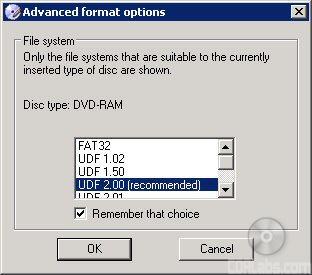 |
To test the drive's DVD-RAM speeds I copied and pasted the same 4GB of files used in our other DVD packet writing tests.
| NEC ND-4550A |
LG GSA-4167B |
|
| InCD Write | 29:39 | 25:51 |
| InCD Read | 11:20 | 15:28 |
| DLA Write | 27:26 | 24:15 |
| DLA Read | 10:28 | 11:13 |
The ND-4550A did fairly well in our DVD-RAM writing tests. While not as fast as the GSA-4167B when writing our test data, it was the faster of the two drives when reading it back.
Double Layer DVD Write Tests - Nero Burning Rom 6.6.0.16:
To test the double layer DVD writing performance of the ND-4550A, I used Verbatim 8x DVD+R DL, Verbatim 2.4x DVD+R DL, Memorex 2.4x DVD+R DL and Verbatim 4x DVD-R DL media. I created about 8GB of random files and directories on my hard drive and then burned them to our test discs with Nero.
NEC's new drive had no problems writing to Verbatim's 8x DVD+R DL media at 8x. The drive was also able to write to Verbatim's 2.4x DVD+R DL media at this speed, but only on the first layer. On the second layer, the writing speed was limited to only 6x. This was still better than Memorex's DVD+R DL media. These Ritek manufactured discs would not work at anything faster than 2.4x.
| NEC ND-4550A |
LG GSA-4167B |
Sony DRU-810A |
Plextor PX-716A |
|
| DVD+R DL Write | 18:36 | 18:47 | 15:13 | 18:17 |
With Nero, it took the ND-4550A about 18:36 to write 8001MB of data. While faster than the drive from LG, it was more than three minutes slower than the DRU-810A. So what about writing quality? Take a look below.
|
|
|
||||||||||||||||||||||||||||||||||||||||||||||||||||||||||||||||||||||||
The writing quality wasn't as good as I had expected with Verbatim's 8x and 2.4x DVD+R DL media. In both cases, the PI/PIF rates were higher than we'd like to see, especially when tested with the BenQ DW1640. Memorex's DVD+R DL media didn't fair any better. While written at a slower speed, the PI/PIF rates were still fairly high. Surprisingly enough, this didn't seem to have any effect on readability. As you can see, both drives had no problems reading the discs back.
The ND-4550A also features 6x DVD-R DL writing speeds. To test the drive's writing times, DVD-R DL media from Verbatim was used.
| NEC ND-4550A |
LG GSA-4167B |
Sony DRU-810A |
Plextor PX-716A |
|
| DVD-R DL Write | 20:42 | 27:00 | 29:23 | 19:01 |
With its Z-CLV writing method, the ND-4550A wasn't as fast as the PX-716A. Nevertheless, it took only 20:42 to write 8001MB of data, beating the drives from LG and Sony by more than 6 minutes. So what about writing quality? Take a look below.
|
||||||||||||||||||||||||
Here too, the ND-4550A's writing quality could have been better. While the PI errors were relatively low when tested with KProbe, the PIF rates were higher than we'd like to see. The PIF rates were lower when tested with the BenQ DW1640. However, as you can see, there were some problems reading the disc back.
Performance Revisited:
The performance of NEC's new "Super-Multi" was, for the most part, pretty mixed. When it came to writing DVD's, the ND-4550A held its own throughout most of our tests. However, there were a number of cases where the writing quality could have been better. Reading DVD's wasn't a problem for the drive. In our tests, the ND-4550A was able to read single layer data DVD's and DVD±R media at speeds near 16x, but slowed to only 7x when reading DVD±R DL discs.
The ND-4550A also did relatively well in our CD reading and writing tests. While its seek times were a little higher than I would have liked, the drive was able to read pressed and CD-R media at speeds as high as 48x. NEC's new drive also performed well in our writing and rewriting tests. The ND-4550A turned in some good writing times and its writing quality was quite good. With all things considered, the NEC ND-4550A gets a 7 out of 10 for the performance section of this review.



